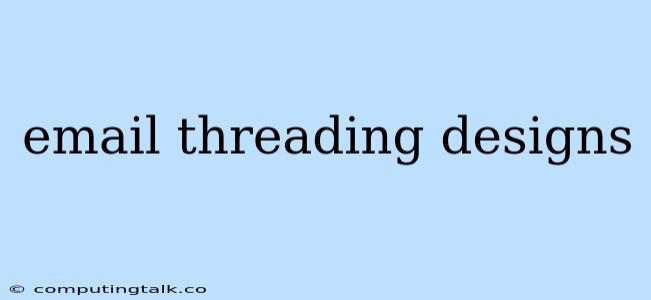Email threading is a fundamental feature in email clients that helps users understand the flow of conversations. It organizes related emails into a logical thread, making it easier to follow the discussion and respond appropriately. Designing effective email threading is crucial for improving user experience and communication efficiency.
Understanding Email Threading
Imagine you're engaged in a conversation with multiple people. Each message you send and receive adds to the ongoing dialogue. Without proper organization, this conversation can quickly become chaotic. This is where email threading comes in. It essentially groups emails based on a common subject, sender, or recipient, creating a visual representation of the conversation's progression.
Key Elements of Email Threading Designs
Several factors contribute to a good email threading design. Let's delve into some of the most crucial ones:
1. Visual Hierarchy
A clear visual hierarchy is essential for easy navigation within email threads. Users should instantly understand which messages belong to which threads, and they should be able to easily differentiate between new and old messages. This could be achieved through:
- Indentations: A common approach is to indent replies to the original message. The deeper the indentation, the further down the conversation tree the message falls.
- Color Coding: Assigning different colors to different threads or even specific senders can enhance visual organization.
- Line Breaks: Clear line breaks between separate emails in a thread help users distinguish between individual messages.
2. Threading Indicators
Visual cues help users quickly grasp the context of a particular email. These indicators could be:
- Subject Lines: Threads should retain a consistent subject line throughout the conversation. This provides a clear reference point for the entire thread.
- Timestamps: Displaying clear timestamps for each message allows users to understand the chronological order of the conversation.
- Sender and Recipient Information: Clearly displaying the sender and recipient of each email ensures users are aware of who is participating in the thread.
3. Navigation and Control
Efficient navigation is key for managing complex email threads. This can be achieved through:
- Threading Collapse/Expansion: Allow users to collapse or expand threads to focus on specific conversations or quickly skim through the overall thread.
- Search Functionality: Provide search functionality within threads to quickly locate specific information or messages.
- Thread Sorting: Allow users to sort threads based on different criteria such as date, sender, or subject.
Best Practices for Email Threading Design
Creating intuitive and user-friendly email threading designs requires careful consideration. Keep these best practices in mind:
- Keep it Simple: Strive for clarity and simplicity. Avoid overly complex visual cues that might overwhelm users.
- Consistency: Ensure consistent threading design across all email clients and platforms for a uniform user experience.
- Accessibility: Consider users with visual impairments. Provide alternative ways to navigate threads, such as keyboard shortcuts or screen reader compatibility.
- User Feedback: Gather user feedback throughout the design process to refine and improve your email threading design.
Examples of Email Threading Designs
Let's take a look at some real-world examples of email threading designs:
- Gmail: Gmail employs a simple, indented threading structure with a consistent subject line throughout the thread. It also features a clear timestamp for each message.
- Outlook: Outlook utilizes a similar indented threading design, with a focus on clear visual hierarchy and easy thread collapse/expansion functionality.
- Yahoo Mail: Yahoo Mail adopts a combination of indented threading and color coding for visual distinction. It also features a "Conversation View" for collapsing and expanding threads.
Conclusion
Effective email threading design is not just about aesthetics; it's about enhancing communication efficiency and user experience. By understanding the key elements, best practices, and examples, you can create email threads that are both visually appealing and functionally intuitive. Users will appreciate the clarity and organization, leading to a more productive and enjoyable email experience.
